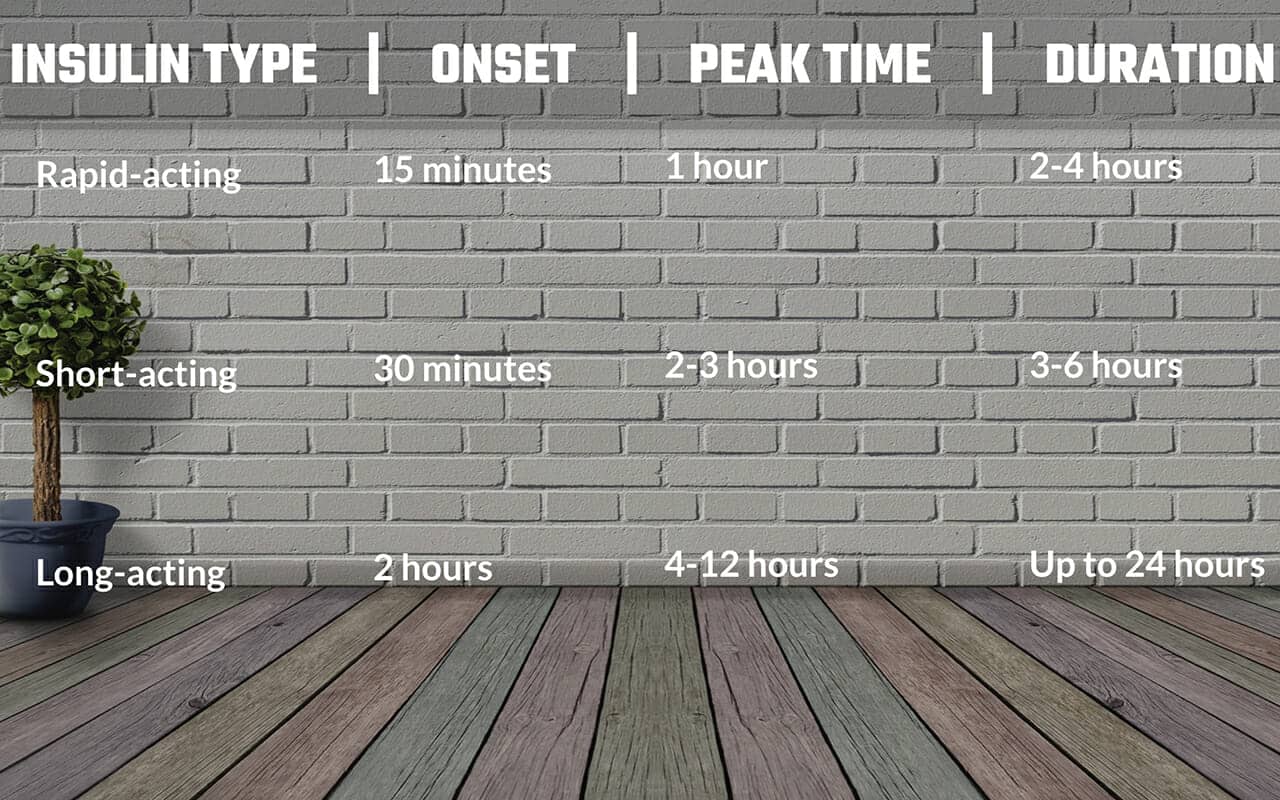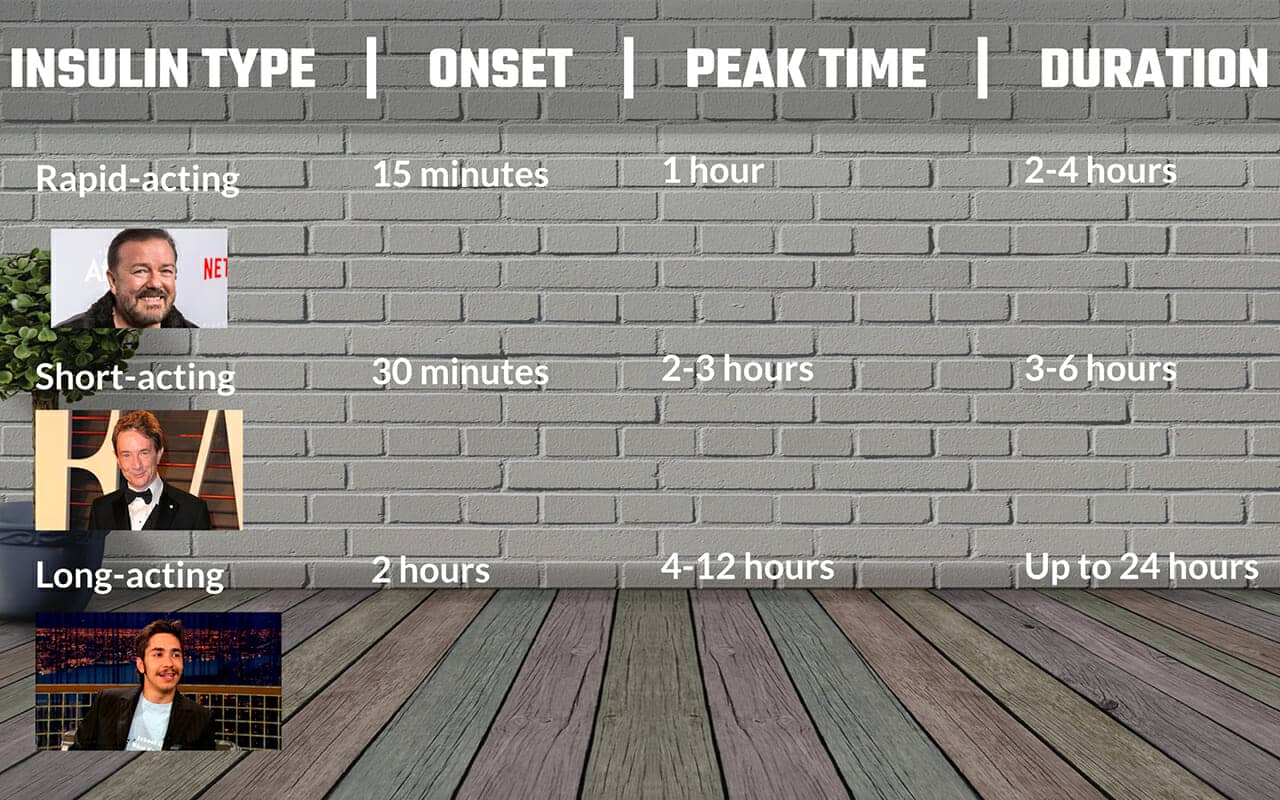
But if you’re struggling to remember insulin peak times and other details, you need more than memory tricks.
You need proper mnemonics.
A bullet proof insulin mnemonic strategy that helps you rapidly memorize everything related to insulin.
That way, you can pass your exams and excel on the job.
Ready to dive in?
Let’s get started.
What Are the 3 Types of Insulin?
Perhaps the easiest task is learning the 3 insulin types:
- Rapid-acting
- Short-acting
- Long-acting
Using the pegword method, you can quickly create mnemonic images for each.
The pegword method gives you an image for each letter of the alphabet. Drawing from my set of associations, I would imagine:
- Ricky Gervais speaking rapidly (rapid-acting)
- Martin Short getting shorter (short-acting)
- Justin Long growing his nose long like Pinocchio (long-acting)
Don’t worry if you don’t know any of these celebrities. This elaborative encoding exercise will help you develop some of your own. It only takes a few minutes, and we know from the science of active recall that when you personalize your associations, you will remember the target information better.
My student Rose Szwed did this and wound up expanding her nursing knowledge very quickly as a result. Personalizing your mnemonics is the best way to study medical terminology across the board.
Now that you’ve got the big picture, let’s dig into some of the more intricate details.
4 Insulin Mnemonics to Help You Remember Any Insulin Onset, Peak, or Duration
Of all the nursing mnemonics you need, knowing exactly how much time involved in the different types of insulin is key.
To really master this learning goal, it will be useful to know and use the Major System. It will help you quickly remember numbers. Or you can use a number-rhyme or number shape system, which I’ll teach you today.
For example, memorizing the insulin onset times and peaks involves numbers like:
- Rapid-acting = 30-90 minutes
- Short-acting = 4-12 hours
How do you handle all of this on top of dealing with drug names?
Let’s take this one step at a time.
One: The Memory Palace Technique
When it comes to the information set related to insulin onset peak duration, it can be challenging to memorize from a table directly. However, the Memory Palace technique makes it much easier. It’s an ancient learning strategy that scholars like Tyson Yunkaporta and David Reser have shown works especially well for learners in medicine.
What’s a Memory Palace? It’s a mental recreation of a familiar space that you use like a kind of canvas. You place associations on it so you can use spaced repetition quickly and easily.
In brief, select a wall in your home or somewhere familiar to you. Then split it into columns. Like this:

As you can see, any wall can be turned into columns.
The next step is to use your characters and place them on the wall too. That way, you have a mental point of reference. Here’s a mnemonic example of what I mean using the main insulin types as described above.
This simple point of reference in a place you’re familiar with can be built upon in many ways.
Two: Number Mnemonics For Remembering Insulin Time Rules
To remember the different onset, peak and duration rules, a memory athlete would use a PAO System built from the Major. I encourage you to learn these intermediate and advanced number systems.
But if you’re just starting out with mnemonics, there’s a much easier way.
For example, using the number shape system, you can imagine that Ricky Gervais is holding a candle to help a seahorse find this way in the darkness under the onset time.
This mnemonic approach works because 1 resembles a candle and 5 looks a bit like a seahorse. Here’s what this would look like once it’s added to your Memory Palace wall:
If you like this approach, all you need is an image for each single digit. Here are the ones I use and teach in the Magnetic Memory Method Masterclass:
- 0 = a donut
- 1 = a candle
- 2 = a swan
- 3 = a moustache on its side or handcuffs
- 4 = a sailboat
- 5 = a seahorse
- 6 = a fishing hook
- 7 = a boomerang
- 8 = a snowman
- 9 = a golf club
You can then populate your Memory Palace with all the numbers and have your celebrities move along the wall in an imaginary journey that will help you quickly memorize the entire table.
Three: Add Specific Drug Names
It’s important to know the names of the different kinds of insulin and how they relate to insulin peak times and the other categories.
For example, short-term acting insulin end in “–lin.” Humulin R and Novolin R are a few examples.
All you have to do is add mnemonics that help you remember these drug names to your existing character. If you’re using Martin Short, you can imagine him injecting Hummus for Humulin while driving a Chevy Nova.
You can add these insulin mnemonics within the same Memory Palace or use another one. The most important step of all is that you supplement this learning process with proper spaced repetition.
Let’s discuss that next.
Four: Enhanced Flashcards for Proper Spaced Repetition
Although it’s possible to use the Memory Palace technique purely on its own, I suggest using flashcards to supplement each learning cycle.
Let’s say that you’re now memorizing that Insulin glargine is a long-acting insulin drug. Before or after placing your association in a Memory Palace, make a quick drawing on a flashcard.

As you can see in my example, I’m not an artist. But I can tell at a glance that its Justin Long glaring at Gina Davis. The act of glaring at Gina is a great mnemonic for glargine.
By adding a swan in the onset category, it’s easy to remember the 2 hour onset rule. You can then add a sailboat for the 4 hour peak time rule, with other images in a straight line in the Memory Palace. The flash cards will help you test yourself as you follow my recommended spaced repetition strategy.
Pro Tip: When using flash cards, it’s useful to not include an answer on the back. Instead, use a notebook to write down the answer you have decoded from the personalized sketch you made.
This simple procedure will help ensure that you form memories faster.
Beyond Insulin Memory Tricks
As you see, this approach uses the basics of mnemonics you see other learning experts discuss.
These mnemonics for the insulin types go one fun and easy step further by showing you how to personalize them. You’ve also discovered how to add beginner, intermediate and advanced number systems.
If you’d like even more intermediate and advanced mnemonics, grab my free memory improvement course here:
It will gives you even more ideas you can use for learning the information related to all aspects of your career.
This includes remembering all things, but especially matters related to patient names, their conditions, symptoms, pharmacology matters, the postural drainage positions and more.
Basically, if you need to memorize it, there are better mnemonic strategies you can use to get the job done in ways that are faster and more fun.
So what do you say?
Are you ready to remember everything related to insulin with greater speed and enjoyment?
Make it happen and thank you for being a medical professional who cares.
Related Posts
- Mnemonic Devices: 8 Detailed Case-Studies For Learning Faster
What are mnemonic devices, and how can you use them to improve memory? This post…
- Mnemonic Examples Of Memorizing Software Principles
Mnemonic examples of how one cool guy memorized software principles.
- 5 Mnemonic Strategies You Can Use to Remember Anything
These 5 mnemonic strategies will help you use every mnemonic device with ease and efficiency.…






